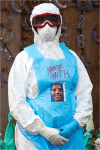PPE Portraits-a Way to Humanize Personal Protective Equipment
- PMID: 32410125
- PMCID: PMC7224350
- DOI: 10.1007/s11606-020-05875-2
PPE Portraits-a Way to Humanize Personal Protective Equipment
Abstract
The use of personal protective equipment (PPE) has skyrocketed, as providers don masks, glasses, and gowns to protect their eyes, noses, and mouths from COVID-19. Yet these same facial features express human individuality, and are crucial to nonverbal communication. Isolated ICU patients may develop "post intensive-care syndrome," which mimics PTSD with sometimes debilitating consequences. While far from a complete solution, PPE Portraits (disposable portrait picture stickers - 4" × 5") have the potential to humanize care. Preparing for a larger effectiveness evaluation on patient and provider experience, we collected initial qualitative implementation insights during Spring 2020's chaotic surge preparation. Front-line providers reported more comfort with patient interactions while wearing PPE Portraits: "It makes it feel less like a disaster zone [for the patient]." A brief pilot showed signs of significant adoption: a participating physician requested PPE Portraits at their clinic, shift nurses had taken PPE Portraits with them to inpatient services, and masked medical assistant team-members requested PPE Portraits to wear over scrubs. We believe PPE Portraits may support patient care and health, and even potentially healthcare team function and provider wellness. While we await data on these effects, we hope hospitals can use our findings to speed their own implementation testing.
Conflict of interest statement
The authors declare that they do not have a conflict of interest.
Figures
References
-
- Pallister-Wilkins P. Personal Protective Equipment in the humanitarian governance of Ebola: between individual patient care and global biosecurity. Third World Q. 2016;37:507–523. doi: 10.1080/01436597.2015.1116935. - DOI
-
- The Integration of the Humanities and Arts with Sciences, Engineering, and Medicine in Higher Education. National Academies Press; 2018. 10.17226/24988 - PubMed
MeSH terms
LinkOut - more resources
Full Text Sources



